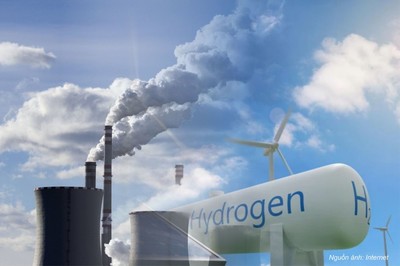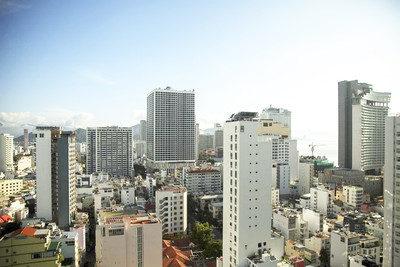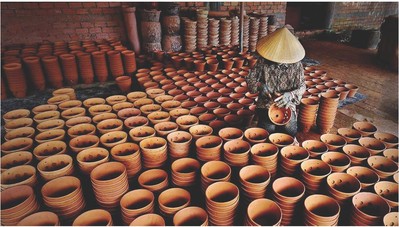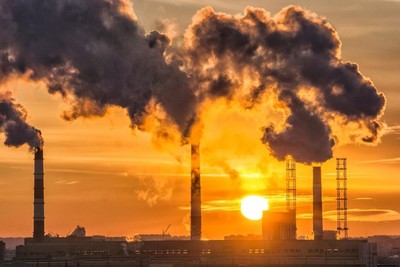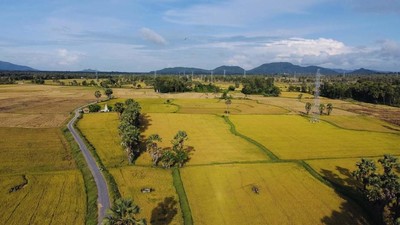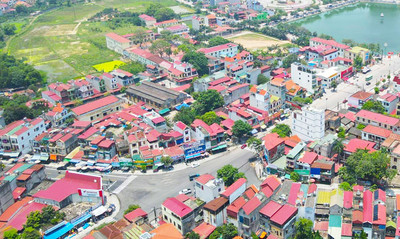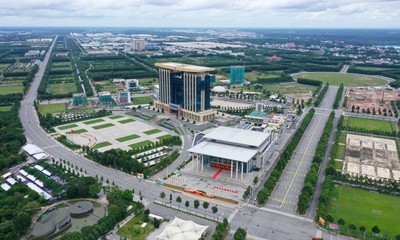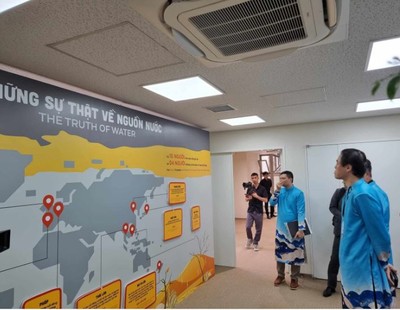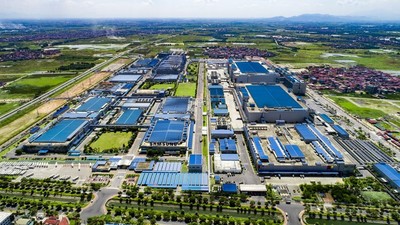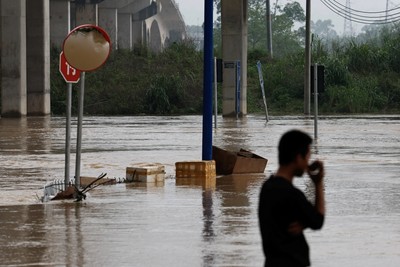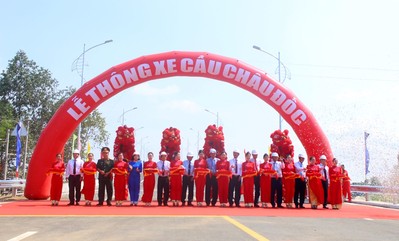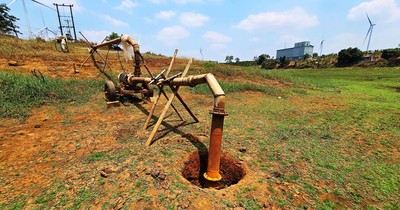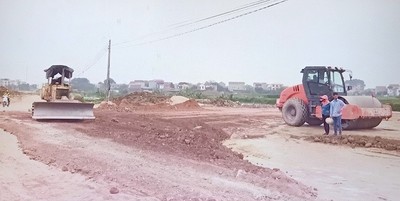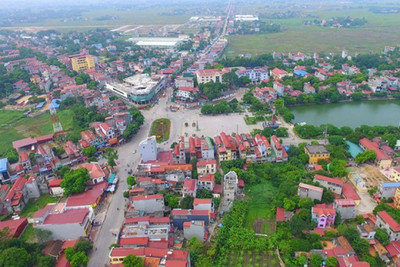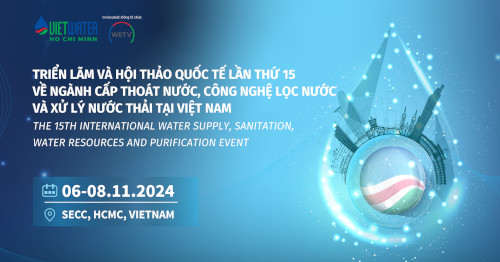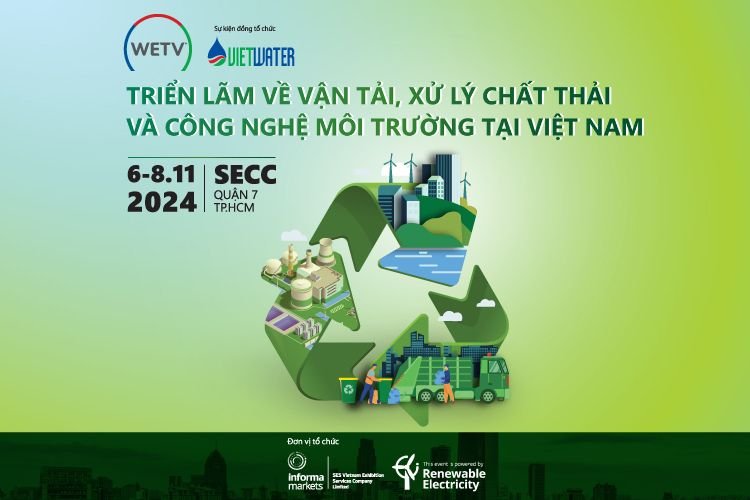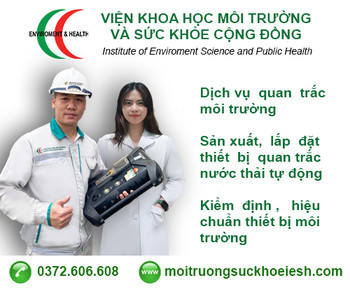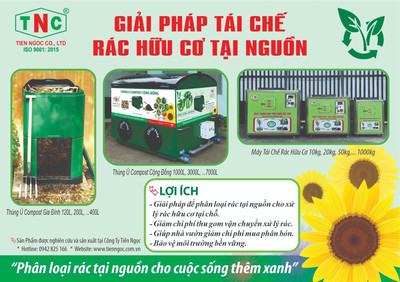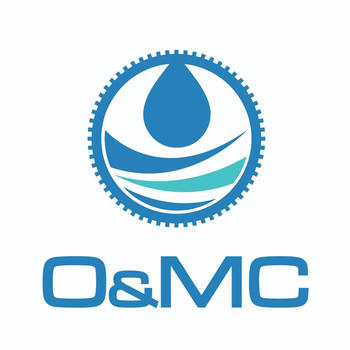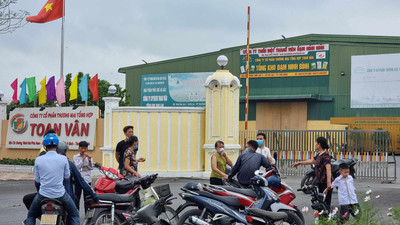Công bố quốc tế lĩnh vực môi trường số 07-2023
Trân trọng giới thiệu tới quý độc giả Công bố quốc tế lĩnh vực môi trường số 07-2023 với những nội dung chính như sau:
Về quản lý môi trường
- Tăng cường ngành tái chế rác thải tại Malang (Indonesia): Bài học từ quản lý rác thải trong kỷ nguyên 4.0
- Đánh giá vòng đời để đánh giá tác động môi trường của hệ thống làm sạch của thành phố. Trường hợp Cracow (Ba Lan)
- Sự lây lan của dịch COVID-19 và các khu vực xanh Ý và Tây Ban Nha từ năm 2020 đến năm 2021: Một nghiên cứu hồi cứu quan sát đa quốc gia
- Phơi nhiễm ô nhiễm không khí trong thời gian dài và mức độ nghiêm trọng của ca bệnh COVID-19: Phân tích dữ liệu cấp độ cá nhân từ Thụy Sĩ
- Đánh giá tác động của các sáng kiến toàn cầu đối với các kịch bản phục hồi đất hiện tại và tương lai ở Ấn Độ
- Vai trò của ô nhiễm không khí và nhiệt độ trong thời gian ngắn đối với tình trạng xơ cứng động mạch trong một nhóm người cao tuổi khép kín theo chiều dọc
- Mối liên hệ giữa việc tiếp xúc ngắn hạn với các chất gây ô nhiễm không khí và tỷ lệ tử vong hàng ngày do nguyên nhân cụ thể ở Ý. Phân tích toàn quốc
- Hướng tới đạt được SDG 6: Các cơ hội dành cho công nghệ khử ion điện dung để cung cấp nước sạch cho người dân châu Phi
- Sự suy giảm tự nhiên được giám sát hợp tác (CMNA) đối với ô nhiễm đất và nước ngầm tại các doanh nghiệp hóa dầu lớn: Một nghiên cứu điển hình
Về môi trường đô thị
- Nồng độ nền tảng uranium trung bình ở các đô thị của Thụy Điển dự đoán tỷ lệ mắc ung thư phổi ở nam giới khi được điều chỉnh theo tỷ lệ hút thuốc: Dấu hiệu cho thấy tác hại tích lũy do radon gây ra
- Các chất ô nhiễm hữu cơ nguy hại trong bụi trong nhà từ các trường tiểu học và mẫu giáo ở Hy Lạp: Hệ lụy đối với sức khỏe trẻ em
- Ô nhiễm không khí trong nhà và các bệnh về mắt ở người: Các chất gây ô nhiễm liên quan và các cơ chế bệnh lý cơ bản
- Đo lường tính không đồng nhất về không gian-thời gian và đặc điểm bên trong của không gian xanh trong các khu dân cư đô thị: Một cách tiếp cận mới sử dụng ma trận đồng thời cấp độ xám
- Tác động nguồn, vận chuyển và khả năng hiển thị của sự phân bố kích thước số lượng hạt dưới kính hiển vi xung quanh trong một khu vực đô thị của miền trung Đài Loan
- Ảnh hưởng của việc thay thế tro bay đốt rác thải đô thị bằng vôi đến việc tạo ra pha liên kết trong quá trình thiêu kết
- Tiềm năng giảm thiểu phát thải khí nhà kính từ hệ thống nước sinh hoạt đô thị tại các khu vực đô thị hóa cao
- Phân tích động lực và dự đoán dấu chân sinh thái trong quá trình tích tụ đô thị dựa trên mô hình STIRPAT mở rộng và các lộ trình kinh tế xã hội chung (SSP)
- Đánh giá tính bền vững so sánh của các cấu hình thay thế của giải pháp loại bỏ nitơ đô thị nhắm vào các con đường khác nhau
- Các khu vực đô thị hóa muộn hơn có sử dụng năng lượng hiệu quả hơn trong lĩnh vực xây dựng không? Bằng chứng từ mô hình khác biệt trong khác biệt
- Chất lượng nước tưới, thạch cao và việc bổ sung phân hữu cơ từ rác thải thành phố ảnh hưởng đến động lực P trong đất nhiễm mặn
Về môi trường khu công nghiệp
- Các mảnh cellulose vi khuẩn được nạp các hạt nano Bi2MoO6 và các chấm lượng tử để phân hủy quang hóa các chất ô nhiễm kháng sinh và thuốc nhuộm
- Nguồn thủy ngân, ô nhiễm, chu trình thủy ngân, kỹ thuật phát hiện và xử lý: Đánh giá
- Phương pháp tiếp cận đa dấu ấn sinh học để đánh giá tác động dưới mức gây chết của các hạt vật chất có thể lắng đọng trong khí quyển từ một khu công nghiệp đối với cá rô phi sông Nile (Oreochromis niloticus)
- Phân tích bao dữ liệu động hai giai đoạn đo lường sự thay đổi năng suất và hiệu quả tổng thể của ngành công nghiệp và nông nghiệp ở các nước EU
- Tính bền vững và khả năng phục hồi môi trường trong một hệ sinh thái bị ô nhiễm thông qua xử lý kim loại nặng và thích nghi sinh lý thực vật
- Một cách tiếp cận bền vững để phân hủy thuốc nhuộm bởi các loài nấm phân lập từ nước thải công nghiệp: Hiệu suất, tối ưu hóa tham số, động học và cơ chế phân hủy
- Điều chế xúc tác gốc hydrochar sinh học cho quá trình fenton trong xử lý nước thải nhuộm
- Phản ứng căng thẳng oxy hóa trong các tế bào phổi tiếp xúc với các phần khác nhau của PM2,5-0,3 từ các khu đô thị, giao thông và công nghiệp
- Các tinh thể nano Cu2ZnSnS4 đa thành phần được điều khiển bằng kim loại quý (Au, Ag) được điều khiển bằng ánh sáng khả kiến: Một chất xúc tác quang chi phí thấp tiềm năng cho nước thải dệt nhuộm và loại bỏ kim loại nặng
- Chuyển đổi chất thải công nghiệp thành vật liệu xi măng có giá trị gia tăng thông qua quá trình cacbon hóa áp suất xung quanh
- Thông tin chi tiết về hỗn hợp Fe–Ni/than sinh học được hỗ trợ loại bỏ điện Fenton ba chiều trong nước thải công nghiệp điện tử
Xin trân trọng giới thiệu!
QUẢN LÝ MÔI TRƯỜNG
1. Assessing magnetic properties of biomonitors and road dust as a screening method for air pollution monitoring
Chemosphere, Volume 310, January 2023, 136795
Abstract
Particulate matter (PM) pollution is one of the world's most serious environmental challenges. Among PM components, atmospheric heavy metals (HMs) are considered one of the main pollutants responsible for causing significant negative impacts on human health, and ecological quality. This study aimed to assess environmental magnetism as a simple and rapid method that can be used to evaluate heavy metal contamination in urban areas from the relationships between magnetic properties and heavy metal concentrations. For this purpose, road dust and leaf samples of two common evergreen species (Cupressus lusitanica/Casuarina equisetifolia) were sampled simultaneously for 2 years at sites with different levels of traffic pollution. The results found significant statistical correlations between the magnetic properties and the chemical substances of the plants studied, as Fe, Cr and V showed an r ≥ 0.9 and Cr and Zn r ≥ 0.7 with χlf in C. equisetifolia. The frequency-dependent magnetic susceptibility was found to be between 0% and 14% for plants, and 0% and 2% for road dust, suggesting a rather dissimilar particle size distribution for plants, and a less important contribution from the more hazardous ultrafine superparamagnetic magnetite for both. Confirming that magnetic analyses can be used to distinguish different degrees of urban air pollution.
2. The evaluation of greenhouse gas emissions from sewage treatment with urbanization: Understanding the opportunities and challenges for climate change mitigation in China's low-carbon pilot city, Shenzhen
Science of The Total Environment, Volume 855, 10 January 2023, 158629
Abstract
Sewage treatment provides a pathway for anthropogenic water purification that can address the growth in domestic sewage volumes due to urbanization and protect the aquatic environment. However, the process can also generate greenhouse gases (GHGs), which are sometimes termed "unrestricted” GHG emissions and are neglected by low carbon policies. A combination of a life cycle analysis (LCA), data envelopment analysis (DEA), and questionnaire survey was used to evaluate sewage treatment related GHG emissions and assess the GHG emission reduction efficiencies during 2005–2020, as well as determine the opinions of environmental managers regarding the threats to climate change mitigation posed by sewage treatment in the low carbon pilot city of Shenzhen, China. There were four main results. (1) GHG emissions from sewage treatment plants (STPs) in Shenzhen increased gradually from 0.22 Mt. CO2-eq in 2005 to 1.16 Mt. CO2-eq in 2020 with an emission intensity ranging from 0.41 to 0.58 kg CO2-eq/m3, mainly due to the indirect emissions from sludge disposal (35–57 %). Longgang administrative district was the hotspot of these GHG emissions during the study period. (2) Reductions in GHG emissions were achieved in most years since 2012 with the greatest efficiency observed in 2020. (3) Beyond the environmental managers' perceptions of the challenges in GHG mitigation, future sewage treatment may create the potential for more substantial GHG emission growth compared to the emissions from energy combustion, due to policy deficiencies, growth in sewage volumes, and the enforcement of stricter effluent quality control. (4) Several opportunities to overcome these barriers were considered including innovational environmental management, planting of constructed wetlands, and the promotion of water-saving behavior. This case study of Shenzhen has valuable implications for the synergistic governance of water pollution and climate change mitigation in megacities in China and elsewhere, enabling a move towards a future carbon-neutral society.
3. Strengthening waste recycling industry in Malang (Indonesia): Lessons from waste management in the era of Industry 4.0
Journal of Cleaner Production, Volume 382, 1 January 2023, 135296
Abstract
Over the past years, Malang (Indonesia) has encountered environmental problems due to municipal solid waste (MSW) overgeneration. Nevertheless, the increasing volume and complexity of MSW management in the city could be tackled using digital solutions. As a key location of ICT development, China is a key partner for Indonesia to improve its MSW management using digital technologies. As a miniature of China's sustainable waste management, Nanning represents a model of smart city that applies resource recovery paradigms using digitalization. Using a case-study approach, this work critically investigates how to strengthen waste recycling industry in Malang using digitalization-based circular economy (CE) according to Nanning's experiences in digitalizing waste recycling. It was found that lessons learnt from Nanning in MSW management were transferable and applicable for Malang to replicate its model, while paving the way forward for a transition towards a CE in waste sector. Traditionally, waste segregation at source was not properly conducted in Malang due to lack of environmental awareness and less public participation, while the waste management in Nanning is time-efficient and cost-effective. Nanning's experiences in digitalizing recyclable materials and/or recycled goods could facilitate Malang to shift towards a digitalization-based CE. Integrating automatic segregation and digitalization at waste banks is efficient in terms of time. With digitalization, over 90% of the solid waste in Malang is segregated properly, while diverting 60% of its non-biodegradable trash from landfills. Overall, the use of digital technologies has enabled waste banks to revolutionize waste industry, while promoting sustainable development at local level. To contribute their share to the UN SDGs, other cities in Indonesia are at their transition towards a digitalization-based CE. There is still a long way for them to attain full circularity and reap the benefits of digital transformation in the waste sector. Hence, it is necessary for stakeholders to promulgate effective policies and strengthen CE implementation on non-biodegradable waste through digital technologies.
4. Presence of novel and legacy flame retardants and other pollutants in an e-waste site in China and associated risks
Environmental Research, Volume 216, Part 4, 1 January 2023, 114768
Abstract
Electrical and Electronic Equipment (EEE) residues and their management have been widely identified as potential sources of plasticizers and flame retardants to the environment, especially in non-formal e-waste facilities. This study evaluates the distribution, partitioning and environmental and human impact of organophosphate esters (OPEs), legacy polychlorinated biphenyls (PCBs), polybromodiphenyl ethers (PBDEs) and organochlorine pesticides (OCPs) in the e-waste recycling area of Baihe Tang village, in the Qingyuan county, Guangdong province, China. A plastic debris lump accumulated in a small pond during years was identified as the main source of pollution with ∑pollutants of 8400 μg/g dw, being OPEs the main contaminants detected, followed by PBDEs. This lump produced the contamination of water, sediments, soils and hen eggs in the surrounding area at high concentrations. Plastic-water and water-sediment partitioning coefficients explained the migration of OPEs to the water body and accumulation in sediments, with a strong dependence according to the KOW. Triphenyl phosphate (TPhP), tricresyl phosphate (TCPs) and high chlorination degree PCBs produced a risk in soils and sediments, considering the lowest predicted no effect concentration, while the presence of PCBs and PBDEs in free range hen eggs exceeded the acceptable daily intake. OCPs were detected at low concentrations in all samples. The presence of organic contaminants in e-waste facilities worldwide is discussed to highlight the need for a strict control of EEE management to minimize environmental and human risks.
5. Life Cycle Assessment for the environmental impact assessment of a city’ cleaning system. The case of Cracow (Poland)
Journal of Cleaner Production, Volume 382, 1 January 2023, 135184
Abstract
In large urban agglomerations, the composition and amount of municipal waste are diversified and depend on the level of wealth, season, number of tourists, etc. In city strategies, there is a visible search for solutions that minimize the impact on the environment and optimize costs incurred by residents. One of the municipal waste streams is street sweepings, i.e. waste generated as a result of street cleaning processes, classified under the code 200303 and is not treated as hazardous waste. Their quantity, quality, and seasonal variability have an impact on the natural environment, including air quality. Their removal reduces the amount of PM10 and PM 2.5. They are usually disposed of the landfills. In Cracow, where air emissions have been successfully reduced in recent years via different actions, experimental studies were carried out on the impact of mechanical street cleaning on air quality, and methods of their management were discussed. The article analyzes various technological solutions based on the LCA (Life Cycle Assessment) methodology for assessing the environmental impact of technologies and waste generated in the processes of street cleaning in urbanized areas. It is used to assess the impact of individual products, technologies, strategies or systems on the environment, taking into account emissions "from the cradle to the grave”. In the latest documents of the European Commission, the LCA method is recommended for the analysis of environmental performance measurement in the life cycle of products and organizations. The presented calculations in the SimaPro software showed that for the adopted assumptions, on the example of a selected street section, it is possible to reduce the impact by 5 times, as a result of city cleaning processes. The calculations take into account the consumption of water, fuel, and the operation of the machinery as well as the management of sweeping waste and wastewater treatment. The process of managing this type of waste reduces emissions related mainly to toxic effects for humans (carcinogenic and non-carcinogenic effects), reduction of solid particles and ecotoxicity for freshwater. Comparing the analyzed scenarios (scenario 1 - after cleaning the city and scenario 0 - before), scenario 1 is characterized by a much lower impact on the environment. Although there are loads in this scenario 1 in each impact category of EF 3.0, the overall result is still lower than in all scenarios 0 options. In scenario 1, the environmental impact mainly relates to the freshwater ecotoxicity, ionizing radiation and climate change categories, which are qualitatively different. From scenario 0, where the greatest environmental impact is in the particulate matter category.
6. Spatial–temporal pattern, driving mechanism and optimization policies for embodied carbon emissions transfers in multi-regional tourism: Case study of provinces in China
Journal of Cleaner Production, Volume 382, 1 January 2023, 135362
Abstract
Tourism is responsible for more than 10% of the global gross domestic product, the growth rate of China's tourism industry is one of the highest in the world. With the continuous prosperity of domestic tourism in China, tourism in China creates large amounts of embodied carbon emissions between regions according to its immense industrial infrastructure and multi-regional mobility. In the context of global climate change and China's "dual carbon target”, the continuous monitoring and analysis of carbon emissions associated with tourism in China are becoming more pressing. This study applied the emissions embodied in the bilateral trade (EEBT) model and structure decomposition analysis (SDA) to analyze the spatial–temporal pattern and driving mechanism of tourism embodied carbon transfers (CETT) between 30 provinces in China. It has been found that the CETT of 30 provinces in China between 1997 and 2012 increased from 33.652 Mt to 164.345 Mt, three times more than previously directly estimated, more provinces in China have become a "net destination” of CETT. Tourism risks becoming an "accelerator” of regional carbon emissions, because of the trend of carbon emissions growing faster than economic growth. Based on carbon-intensity analysis, the main driving forces of net CETT were explored: low-carbon technology of tourism products and services, tourist origin structure, and tourist market scale. Technology driving force and structure driving force reduced net CETT outflows by 64.98 Mt and 646.30 Mt, respectively, 1997 to 2012, while the scale driving force increased by 714.28 Mt. This study puts forward specific implements on the regulation and control of CETT in China's from tourism route, supply chain, and government regime by combining quantitative and qualitative methods. This study proposed a research framework of "measure-intensity-driver-regulation” for CETT and connected with the forefront of global climate change research, in order to effectively guide the low-carbon transformation and development of tourism with new tools and methods, and provide a reference for low-carbon green development in the post-pandemic era for the world.
7. Innovation incentives and urban carbon dioxide emissions: A quasi-natural experiment based on fast-tracking green patent applications in China
Journal of Cleaner Production, Volume 382, 1 January 2023, 135444
Abstract
Carbon dioxide (CO2) emissions reduction has become a core task with the goal of "emission peak and carbon neutrality”, in which green innovation plays an important role. This paper takes the fast-tracking green patent applications (FGPA) system in China as a quasi-natural experiment to empirically study the impact of green innovation incentive-based policies (GIIPs) on CO2 emissions in Chinese cities by applying a continuous difference-in-difference approach. The results show that the CO2 emissions of cities in the treatment group are significantly reduced by about 1.6% after the implementation of FGPA relative to that in the control group. After a series of robustness tests, the conclusion is still valid. Furthermore, the significant negative impact on CO2 emissions is more reflected in cities located in eastern China, cities with lower financial pressure, and cities with more universities. Overall, this study fills up the gap in the empirical research on the impact of FGPA, and casts a new light on the significant environmental performance of GIIPs. The findings obtained through this study are conducive to strengthening and optimizing the implementation of FGPA, and offering policy-makers with a scientific basis of GIIPs to approach the task of reducing CO2 emissions.
8. An integrated analysis framework for water resources sustainability considering fairness and decoupling based on the water resources ecological footprint model: A case study of Xinjiang, China
Journal of Cleaner Production, Volume 383, 10 January 2023, 135466
Abstract
One of the critical barriers to water resources sustainability (WRS) is the poor understanding of water scarcity, and the water resources ecological footprint (WEF) has become an important tool for assessing WRS due to its insight into the water shortage crisis. In this study, an integrated diagnostic framework was developed by combining the three-dimensional water resources ecological footprint (3D WEF) model and the Gini coefficient approach as well as the decoupling effort model to comprehensively analyze WRS. It can not only fully reveal water shortages from three dimensions of water resources ecological deficit (WED), the size and depth of WEF, but also further evaluate the performance of WEF in terms of fairness and decoupling. Then, the framework was applied to examine WRS in Xinjiang, China from 2004 to 2018. The results indicated that: (1) The production sector contributes above 90% of WEF, and the share of WEF generated by ecological environment water is rising; (2) the increasing trend in WED implies that WRS is deteriorating; (3) GDP-WEF was at an extremely unfair level as the less economically developed cities of the South occupy WEF without contributing to the corresponding economic output; (4) from the 10th to the 13th Five-Year Plan, the proportion of strongly decoupled cities rose from 42.9% to 71.4%, with technological factors responsible for the most significant decoupling efforts. These findings offer direct support for improving local human-water relations and promoting the coordination of WRS and socio-economic development.
9. COVID-19 epidemic spread and green areas Italy and Spain between 2020 and 2021: An observational multi-country retrospective study
Environmental Research, Volume 216, Part 1, 1 January 2023, 114089
Abstract
Several studies have proposed that environmental factors influencing human wellbeing, such as chronic exposures to high levels of particulate matter, could indirectly or even directly affect also the severity of COVID-19 disease in case of infection by novel coronavirus SARS-COV2. This study has investigated the association between COVID-19 infections, hospitalizations or deaths and the extension of public green areas (km2 per 100,000 based on OECD data of 2014), an indicator that has been chosen as independent endpoint variable to test the research hypothesis in 10 Italian and 8 Spanish Provinces with more than 500.000 inhabitants, including capitals (Rome and Madrid) and bigger cities (Bologna, Catania, Florence, Genoa, Milan, Naples, Palermo, Turin and Venice for Italy; Barcelona, Valencia, Seville, Zaragoza, Malaga, Las Palmas and Bilbao for Spain). Two different methodologies have been applied: a bottom-up approach was applied to Spanish institutional data concerning contagions/hospitalizations/deaths and the extent of public green areas for each responder to an official questionnaire in the frame of a nationwide survey (with detailed data granularity per province) containing specific georeferenced information; a top-down approach was used for Italy, starting from the official figures of contagions/hospitalizations/deaths of each province and linking them to the OECD statistics about the extension of public green areas in the different areas. Linear and generalized models were used for statistical analyses including also PM2.5 in a multivariate approach (with annual average concentrations from official air quality monitoring stations) and were able to adjust for the different number inhabitants living in each province, in order to take into account the difference in contagion dynamics related to the different density of population. The results obtained for Spain are consistent with those observed for Italy, as for both countries, it has clearly emerged a statistically significant association between COVID-19 clinical features (contagions, hospitalizations, and deaths) and the extension of public green areas, as well as the annual average concentrations of PM2.5 (with this latter variable loosing statistical significance in some province). Therefore, the extension of public green areas and air pollution seem to have a high correlation with COVID-19 severity.
10. Long-term air pollution exposure and COVID-19 case-severity: An analysis of individual-level data from Switzerland
Environmental Research, Volume 216, Part 1, 1 January 2023, 114481
Abstract
Several studies are pointing out that exposure to elevated air pollutants could contribute to increased COVID-19 mortality. However, literature on the associations between air pollution exposure and COVID-19 severe morbidity is rather sparse. In addition, the majority of the studies used an ecological study design and were applied in regions with rather high air pollution levels. Here, we study the differential effects of long-term exposure to air pollution on severe morbidity and mortality risks from COVID-19 in various population subgroups in Switzerland, a country known for clean air. We perform individual-level analyses using data covering the first two major waves of COVID-19 between February 2020 and May 2021. High-resolution maps of particulate matter and nitrogen dioxide concentrations were produced for the 6 years preceding the pandemic using Bayesian geostatistical models. Air pollution exposure for each patient was measured by the long-term average concentration across the municipality of residence. The models were adjusted for the effects of individual characteristics, socio-economic, health-system, and climatic factors. The variables with an important association to COVID-19 case-severity were identified using Bayesian spatial variable selection. The results have shown that the individual-level characteristics are important factors related to COVID-19 morbidity and mortality in all the models. Long-term exposure to air pollution appears to influence the severity of the disease only when analyzing data during the first wave; this effect is attenuated upon adjustment for health-system related factors during the entire study period. Our findings suggest that the burden of air pollution increased the risks of COVID-19 in Switzerland during the first wave of the pandemic, but not during the second wave, when the national health system was better prepared.
11. Assessing the impact of global initiatives on current and future land restoration scenarios in India
Environmental Research, Volume 216, Part 1, 1 January 2023, 114413
Abstract
Land degradation across the world has resulted in an unprecedented decline of ecosystem services, affecting the livelihood of 3.2 billion people globally. Sustainable land management is essential to protect our finite land resources from over-exploitation and degradation. Therefore, the present article was aimed to analyze the impacts of various national and international policies on current and future land restoration scenarios in India. A spatially explicit model (CLUMondo) was employed to predict scenarios, i.e., the ‘business as usual’ (BU) and ‘sustainable restoration’ (SR) by 2030. Though the results showed an increasing trend in land degradation , i.e., from 44.28 to 49.74 Mha during the period of 2005–15, a slight decrease was observed in 2019 (49.24 Mha), suggesting a net increase of 11.21% during the 2005–19 period. However, an increase in forest cover by 5.08% under existing policy targets overtook the degradation rate by restoration initiatives. The net decline in degraded land area by 1% with an increased forest cover by 1.83% observed during the 2015–19 periods reflected the positive impact of various national and global policies on existing restoration ventures in India. Our modeled results (weighted AUC = 0.87) also suggested an increase in forest cover by 6.9% and 9.9% under BU and SR scenarios, respectively. Under the BU scenario, degraded land will be restored up to 12.1 Mha; however, 6.27 Mha of these lands will be converted to cropland for food production. Importantly, a decrease in grasslands by 35.1% under the BU scenario warrants the urgency to maintain the integrity of such ecological systems. However, the SR scenario showed an increase in grasslands by 8.9%, with an overall restoration of degraded land up to 18.31 Mha. Moreover, a reduced cropland expansion rate of 1% suggested an effective land management response. While our results may have some uncertainties due to the model limitations, they can still be used for framing suitable land management policies to facilitate sustainable land restoration programs in India.
12. Association between long-term ambient ozone exposure and attention-deficit/hyperactivity disorder symptoms among Chinese children
Environmental Research, Volume 216, Part 2, 1 January 2023, 114602
Abstract
Background
Although ozone exposure has neurological toxicity, it remains unclear whether it was associated with an increased risk of attention-deficit/hyperactivity disorders (ADHD) among childhood.
Methods
We matched the four-year average ozone concentration with questionnaire data for 35,103 children aged 3–12 years from seven cities in Liaoning, China, 2012–2013. Using mixed-effect logistic regression models, we assessed the association of ozone concentration with multiple ADHD indicators using the Conners Abbreviated Symptom Questionnaire (C-ASQ), including explicit attention-deficit/hyperactivity symptoms (ADHD; score ≥15), attention-deficit/hyperactivity disorder tendencies (ADHD-T; 11 ≤ score ≤14), and attention-deficit/hyperactivity problems (ADHP; score ≥11). Results were also stratified by sociodemongraphics.
Results
After adjusting for covariates, we found that each interquartile range (IQR) increase in ozone concentration was associated with an increased risk of ADHD, ADHD-T, and ADHP (P < 0.001) with an odds ratio of 1.12 (95% confidence interval, 1.04–1.21), 1.08 (1.03–1.13), and 1.09 (1.05–1.14), respectively. Additionally, we found greater effect estimates in children who reported longer exercise time (vs those with limited exercise time) with odds ratio of 1.18 (1.07–1.31) vs 1.06 (0.96–1.17) for ADHD, 1.13 (1.06–1.21) vs 1.03 (0.96–1.10) for ADHD-T, and 1.15 (1.08–1.21) vs 1.04 (0.98–1.10) for ADHP. Non-breastfed children were also shown to be more vulnerable to ADHD with an odds ratio of 1.22 (1.09–1.36) compared with 1.06 (0.96–1.16) among the rest.
Conclusions
Long-term ozone exposure may be associated with increased ADHD among children. Additional studies are needed to validate our findings and support policies and interventions to address this growing public health concern.
13. The role of short-term air pollution and temperature on arterial stiffness in a longitudinal closed cohort of elderly individuals
Environmental Research, Volume 216, Part 2, 1 January 2023, 114597
Abstract
Background/Aims
Our study adds to the sparse literature that examines whether arterial stiffness, related to cardiovascular risk, increases with exposure to air pollution. We assessed the associations between spatiotemporally resolved air pollutants and vascular and hemodynamic parameters in an elderly population-based in Eastern Massachusetts.
Methods
Among 397 men living in Eastern Massachusetts between 2007 and 2013, we utilized time-varying linear mixed-effects regressions to examine associations between central augmentation index (%) and central pulse pressure (mmHg) and short-term (0–7 days) exposure to air pollution concentrations (fine particulate matter (PM2.5), nitrogen dioxide (NO2), ozone (O3)), and temperature adjusted for known cardiovascular risk factors. Central augmentation index (AIx) and pulse pressure (AP) were measured at each visit using radial artery applanation tonometry for pulse wave analysis. Each air pollutant and temperature were geocoded to the participant's residential address using validated ensemble and hybrid exposure models and gridMET predictions.
Results
We found consistent results that higher short-term PM2.5 concentrations (0–7 day moving averages) were associated with significantly higher measures of arterial stiffness. Each 4.52 μg/m3 interquartile range (IQR) increase in daily PM2.5 for a 3-day moving average was associated with a 0.63% (95% confidence interval (CI): 0.11, 1.15) increase in AIx and a 1.65 mmHg (95% CI: 0.42, 2.88) increase in pulse pressure. Furthermore, each 3.83 μg/m3 IQR increase in daily PM2.5 for a 7-day moving average was associated with a 0.57% (95% CI: −0.01, 1.14) increase in AIx and a 1.91 mmHg (95% CI: 0.54, 3.28) increase in pulse pressure. Smaller increases in AIx and AP were observed for the other short-term moving averages of PM2.5 exposure apart from days zero and five for AIx. We found no clear association between O3, NO2, temperature, and the outcomes.
Conclusions
Short-term PM2.5 exposure was associated with markers of arterial stiffness and central hemodynamics.
14. Association between short-term exposure to air pollutants and cause-specific daily mortality in Italy. A nationwide analysis
Environmental Research, Volume 216, Part 3, 1 January 2023, 114676
Abstract
Background/aim
Daily air pollution has been linked with mortality from urban studies. Associations in rural areas are still unclear and there is growing interest in testing the role that air pollution has on other causes of death. This study aims to evaluate the association between daily air pollution and cause-specific mortality in all 8092 Italian municipalities.
Methods
Natural, cardiovascular, cardiac, ischemic, cerebrovascular, respiratory, metabolic, diabetes, nervous and psychiatric causes of death occurred in Italy were extracted during 2013–2015. Daily ambient PM10, PM2.5 and NO2 concentrations were estimated through machine learning algorithms. The associations between air pollutants and cause-specific mortality were estimated with a time-series approach using a two-stage analytic protocol where area-specific over-dispersed Poisson regression models where fit in the first stage, followed by a meta-analysis in the second. We tested for effect modification by sex, age class and the degree of urbanisation of the municipality.
Results
We estimated a positive association between PM10 and PM2.5 and the mortality from natural, cardiovascular, cardiac, respiratory and nervous system causes, but not with metabolic or psychiatric causes of death. In particular, mortality from nervous diseases increased by 4.55% (95% CI: 2.51–6.63) and 9.64% (95% CI: 5.76–13.65) for increments of 10 μg/m3 in PM10 and PM2.5 (lag 0–5 days), respectively. NO2 was positively associated with respiratory (6.68% (95% CI: 1.04–12.62)) and metabolic (7.30% (95% CI: 1.03–13.95)) mortality for increments of 10 μg/m3 (lag 0–5). Higher associations with natural mortality were found among the elderly, while there were no differential effects between sex or between rural and urban areas.
Conclusions
Short-term exposure to particulate matter was associated with mortality from nervous diseases. Mortality from metabolic diseases was associated with NO2 exposure. Other associations are confirmed and updated, including the contribution of lowly urbanised areas. Health effects were also found in suburban and rural areas.
15. Towards attaining SDG 6: The opportunities available for capacitive deionization technology to provide clean water to the African population
Environmental Research, Volume 216, Part 3, 1 January 2023, 114671
Abstract
The unavailability of clean water caused by population growth, increased industrial activities, and global climate change is a major challenge in many communities. A number of desalination technologies including distillation, reverse osmosis and electrodialysis, have been used to supplement the available water resources. However, these technologies are energy intensive and demand a significant financial commitment. Capacitive deionization (CDI) is an emerging desalination technology which is promising to provide water at a reasonable cost, especially in societies with limited incomes such as those in Africa. The opportunities for CDI to provide clean water to the African population are discussed in this paper. These opportunities include electrosorption at low potential, low energy consumption, large quantities of agricultural wastes for the production of electrode materials, high sunshine irradiation throughout the year, suitability for disinfection and defluoridation and its applications in the removal of heavy metals and emerging pollutants. Due to the existence of numerous enabling conditions, the analysis from this paper demonstrates that CDI can be a dependable method to provide clean water in Africa.
16. The collaborative monitored natural attenuation (CMNA) of soil and groundwater pollution in large petrochemical enterprises: A case study
Environmental Research, Volume 216, Part 4, 1 January 2023, 114816
Abstract
A large in-service petrochemical enterprises in Northeast China was taken as the research object, and the Collaborative Monitored Natural Attenuation (CMNA) for soil and groundwater pollution was carried out to remedy combined pollution and reduce environmental risks. The pollutants distributions were obtained based on detailed regional investigation (Mar. 2019), and feature pollutants in soil and groundwater were then screened. The spatiotemporal variations of feature pollutants and relative microbial responses were explored during the CMNA process. Furthermore, the CMNA efficiency of the contaminated site at initial stage was evaluated by calculation of natural attenuation rate constant. The results showed that the feature pollutants in soil were 2,2′,5,5′-tetrachlorobiphenyl (2,2′,5,5′-TCB) and petroleum hydrocarbons (C10∼C40), and the feature pollutant in groundwater was 1,2-dichloroethane (1,2-DCA). The concentrations of all feature pollutants decreased continuously during four years of monitoring. Feature pollutants played a dominant role in the variability of microbial species both in soil and groundwater, increasing the relative abundance of petroleum tolerant/biodegradation bacteria, such as Actinobacteria, Proteobacteria and Acidobacteriota. The average natural attenuation rate constant of 2,2′,5,5′-TCB and C10∼C40 in soil was 0.0012 d−1 and 0.0010 d−1, respectively, meeting the screening value after four years' attenuation. The average natural attenuation rate constant of 1,2-DCA was 0.0004 d−1, which need strengthening measures to improve the attenuation efficiency.
MÔI TRƯỜNG ĐÔ THỊ
1. Average uranium bedrock concentration in Swedish municipalities predicts male lung cancer incidence rate when adjusted for smoking prevalence: Indication of a cumulative radon induced detriment
Science of The Total Environment, Volume 855, 10 January 2023, 158899
Abstract
Bedrock U has been used as a proxy for local indoor radon exposure. A preliminary assessment of cancer incidence rate in a cohort of 809,939 adult males living in 9 different Swedish counties in 1986 has been used to correlate the cumulative lung cancer and total cancer (excluding lung) incidence rates between 1986 and 2020, respectively with the municipality average value of bedrock U concentration obtained from Swedish geological Survey (SGU). To control for regional difference in tobacco smoking, data on county average smoking prevalence, obtained from a survey conducted by the Public Health Agency of Sweden from 2001 to 2004, was used. Regression analysis shows that there is a significant positive correlation between smoking prevalence adjusted lung cancer incidence rate in males and the municipality bedrock U concentration (R2 = 0.273 with a slope 5.0 ± 0.87·10−3 ppm−1). The correlation is even more significant (R2 = 0.759 with a slope = 4.8 ± 0.25·10−3 ppm−1) when assessed on population weighted cancer incidence data binned in nine intervals of municipality average bedrock U concentration (ranging from 0.97 to 4.9 ppm). When assessing the corresponding correlations for total cancer incidence rate (excluding cancer of the lung) with adjustment for smoking prevalence, there appears to be no or little correlation with bedrock U concentration (R2 = 0.031). We conclude that an expanded future study needs age-standardized cancer incidence data to obtain a more consistent exposure-response model. Such model could be used to predict future lung cancer cases based on geological survey maps of bedrock U as an alternative to laborious indoor radon measurements, and to discern what future lung cancer rates can be expected for a population nearing zero smoking prevalence, with and without radon prevention.
2. Hazardous organic pollutants in indoor dust from elementary schools and kindergartens in Greece: Implications for children's health
Chemosphere, Volume 310, January 2023, 136750
Abstract
Children spend a significant portion of their day in school, where they may be exposed to hazardous organic compounds accumulated in indoor dust. The aim of this study was to evaluate the concentrations of major hazardous organic contaminants in dust collected from kindergartens and elementary schools in Northern Greece (n = 20). The sum concentrations of 20 targeted polybrominated diphenyl ether congeners (∑20PBDEs) in dust varied from 58 ng g−1 to 1480 ng g−1, while the sum of 4 novel brominated fire retardants (∑4NBFRs) ranged from 28 ng g−1 to 555 ng g−1. Correspondingly, the sum concentrations of phthalate esters (∑9PAEs) ranged between 265 μg g−1 and 2120 μg g−1, while the sum of organophosphate esters (∑11OPEs) was found between 2890 ng g−1 and 16,100 ng g−1. Finally, the sum concentrations of polycyclic aromatic hydrocarbons (∑16PAHs) were found within in the range 212 ng g−1 and 6960 ng g−1. Exposure to indoor dust contaminant via inhalation, ingestion and dermal absorption was investigated for children and adults (teachers). Carcinogenic and non-carcinogenic risks were also estimated. Children's estimated intakes of individual hazardous chemicals via the three exposure routes, were lower than the available health-based reference values.
3. Indoor air pollution and human ocular diseases: Associated contaminants and underlying pathological mechanisms
Chemosphere, Volume 311, Part 2, January 2023, 137037
Abstract
People spend a long time indoors, especially young children. The risk of indoor pollution on human health is one of the current hotspots in environmental and public health. The human ocular surface is highly susceptible to indoor environment quality. Epidemiological data have linked human ophthalmological disorders with exposure to indoor pollution. In this review, we summarized the adverse impacts of indoor pollution on the human ocular surface. Several studies demonstrated that indoor contaminants including particulate matter, volatile/semi-volatile organic compounds, heavy metals, and fuel combustion and cigarette smoke exposure were associated with the incidence of human dry eye, conjunctivitis, glaucoma, cataracts, age-related macular degeneration, and keratitis. In addition, toxicological investigations revealed that indoor pollution-induced induced chronic inflammation, oxidative damage, and disruption of tight junctions are the main underlying pathological mechanisms for ocular surface diseases. Taken together, this review may expand the understanding of pollution-induced eye disorder and highlight the importance of reducing associated contaminants to decrease their detrimental effects on human eyes.
4. Measuring spatio-temporal heterogeneity and interior characteristics of green spaces in urban neighborhoods: A new approach using gray level co-occurrence matrix
Science of The Total Environment, Volume 855, 10 January 2023, 158608
Abstract
Urban green space (UGS) is a complex and highly dynamic interface between people and nature. The existing methods of quantifying and evaluating UGS are mainly implemented on the surface features at a landscape scale, and most of them are insufficient to thoroughly reflect the spatial-temporal relationships, especially the internal characteristics changes at a small scale and the neighborhood spatial relationship of UGS. This paper thus proposes a method to evaluate the internal dynamics and neighborhood heterogeneity of different types of UGS in Leipzig using the gray level co-occurrence matrix (GLCM) index. We choose GLCM variance, contrast, and entropy to analyze five main types of UGS through a holistic description of their vegetation growth, spatial heterogeneity, and internal orderliness. The results show that different types of UGS have distinct characteristics due to the changes of surrounding buildings and the distance to the built-up area. Within a one-year period, seasonal changes in UGS far away from built-up areas are more obvious. As for the larger and dense urban forests, they have the lowest spatial heterogeneity and internal order. On the contrary, the garden areas present the highest heterogeneity. In this study, the GLCM index depicts the seasonal alternation of UGS on the temporal scale and shows the spatial form of each UGS, being in line with local urban planning contexts. The correlation analysis of indices also proves that each type of UGS has its distinct temporal and spatial characteristics. The GLCM is valid in assessing the internal characteristics and relationships of various UGS at the neighborhood scales, and using the methodology developed in our study, more studies and field experiments could be fulfilled to investigate the assessment accuracy of our GLCM index approach and to further enhance the scientific understanding on the internal features and ecological functions of UGS.
5. Sources, transport, and visibility impact of ambient submicrometer particle number size distributions in an urban area of central Taiwan
Science of The Total Environment, Volume 856, Part 2, 15 January 2023, 159070
Abstract
This study applied positive matrix factorization (PMF) to identify the sources of size-resolved submicrometer (10–1000 nm) particles and quantify their contributions to impaired visibility based on the particle number size distributions (PNSDs), aerosol light extinction (bp), air pollutants (PM10, PM2.5, SO2, O3, and NO), and meteorological parameters (temperature, relative humidity, wind speed, wind direction, and ultraviolet index) measured hourly over an urban basin in central Taiwan between 2017 and 2021. The transport of source-specific PNSDs was evaluated with wind and back trajectory analyses. The PMF revealed six sources to the total particle number (TPN), surface (TPS), volume (TPV), and bp. Factor 1 (F1), the key contributor to TPN (35.0 %), represented nucleation (<25 nm) particles associated with fresh traffic emission and secondary new particle formation, which were transported from the west-southwest by stronger winds (>2.2 m s−1). F2 represented the large Aitken (50–100 nm) particles transported regionally via northerly winds, whereas F3 represented large accumulation (300–1000 nm) particles, which showed elevated concentrations under stagnant conditions (<1.1 m s−1). F4 represented small Aitken (25–50 nm) particles arising from the growth and transport of the nucleation particles (F1) via west-southwesterly winds. F5 represented large Aitken particles originating from combustion-related SO2 sources and carried by west-northwesterly winds. F6 represented small accumulation (100–300 nm) particles emitted both by local sources and by the remote SO2 sources found for F5. Overall, large accumulation particles (F3) played the greatest role in determining the TPV (66.4 %) and TPS (34.8 %), and their contribution to bp increased markedly from 17.3 % to 40.7 % as visibility decreased, indicating that TPV and TPS are better metrics than TPN for estimating bp. Furthermore, slow-moving air masses—and therefore stagnant conditions—facilitate the build-up of accumulation mode particles (F3 + F6), resulting in the poorest visibility.
6. Cross-media transfer of nitrogen pollution in the fast-urbanized Greater Bay Area of China: Trends and essential control pathsAbstract
Journal of Environmental Management, Volume 326, Part B, 15 January 2023, 116796
Research article
For urban agglomerations in the bay area, which concentrate multiple environmental elements and intense anthropogenic activities, comprehensive control of nitrogen pollution is particularly challenging due to diverse cross-media migration and transformation forms of nitrogen pollutants. Existing studies on urban nitrogen metabolism mainly focused on quantification of nitrogen flux, without systematic consideration of physiochemical changes of nitrogen between environmental media. This study conducted a dynamic simulation of nitrogen cross-media metabolism in urban agglomeration over 30 consecutive years, and recognized the types, quantities, and trends of cross-media transfer of nitrogen pollution as well as pollution control paths based on ecological network analysis and scenario analysis. Taking the Guangdong-Hong Kong-Macao Greater Bay Area as the case, results show that during its fast-urbanized stage in 1989–2018, more than 25% of the total nitrogen pollution emissions were transferred from other media. The higher degree of imbalance between the socioeconomic system and the soil in the nitrogen metabolic network emphasizes the increased pressure and necessity of pollution control of nitrogen in the solid state with urban development. Promoting fertilizer reduction and sludge land use are priority paths for collaborative control of cross-media nitrogen pollution. The study provides methods to systematically analyze the features of cross-media transfer of nitrogen pollution at the city level, and accordingly propose paths aiming at sustainable urban nitrogen management with multi-media integrity and synergy.
7. Effects of substituting municipal waste incineration fly ash for lime on generating a bonding phase during the sintering process
Journal of Cleaner Production, Volume 382, 1 January 2023, 135022
Abstract
As the main solid by-product of municipal waste incineration, the safe treatment and resource utilization of municipal waste incineration fly ash (hereafter referred to as fly ash), comprising a large amount of CaO, SiO2, Al2O3, and related compounds, has become an exceedingly important environmental concern. Owing to its alkaline composition, herein we propose that fly ash replaces lime as a part of the flux used in the sinter process. Following a combined approach using thermodynamic calculations and experimental verification, we found that CaO from fly ash can combine with Fe2O3 to form complex calcium ferrite, which can effectively replace lime to form the binder phase for the sintering process. In addition, a small amount of Al2O3 impurities present in fly ash promotes the formation of acicular calcium ferrite with an interwoven structure, which improves the reducibility and mechanical strength of the sintered ore. However, when the proportion of fly ash replacing lime is too high and results in an Al2O3 content greater than 2%, the acicular calcium ferrite is transformed to the plate state, which deteriorates the metallurgical properties of the sintered ore. Furthermore, alkaline metal chlorides (e.g., KCl and NaCl) present in fly ash can improve the dissolution of Al2O3 and SiO2 in silicate, which impedes the performance of the binder phase. However, most of the alkali metal chlorides are volatilized, and only a small amount remains in the form of oxides, which have little effect on the performance of the sintered binder phase. Overall, the best metallurgical properties were obtained when fly ash replaced 25% lime as the sintering alkaline flux. Therefore, replacing lime with fly ash to form the binder phase during sintering holds excellent application prospects.
8. The potential of mitigating greenhouse gas emissions from urban domestic water systems in highly urbanized areas
Journal of Cleaner Production, Volume 382, 1 January 2023, 135206
Abstract
In highly urbanized areas, domestic water consumption and wastewater discharge are affected by several dynamic factors, such as economy, population, and environment, which further influence the greenhouse gas (GHG) mitigation potential of urban domestic water systems (UDWSs). To analyze GHG emission features of the UDWSs and their interactions with urban economic development, a hybrid approach of correlation analysis and a programming model was incorporated in a life-cycle framework to provide decision-making support for GHG mitigation strategies in the UDWSs. To verify the applicability of the method, Shenzhen city in Guangdong Province was chosen to analyze the potential of the UDWS for mitigating GHG emissions. The GHG emissions from the UDWS in Shenzhen was 747.82 kt CO2 eq in 2020. Compared with 2020, domestic water consumption would increase by 11.35 % and 18.67 % in 2025 and 2030, and wastewater discharge would increase by 12.88 % and 19.73 % in 2025 and 2030, respectively. In the trend of socio-economic development, the amount of water demand and wastewater discharge of urban residents would increase by 11.49 % to 18.75 % and 12.88 % to 19.75 % from 2020 to 2030, respectively. Optimum strategies of technologies for wastewater treatment and energy mix for electricity generation were obtained, with consideration of GHG mitigation goals in the future. As energy consumption contributed more than 25 % of GHG emissions in the USDWs of Shenzhen, the contributions of new energy sources for electricity production (i.e., offshore wind, solar photovoltaic, biomass, and nuclear) would increase by 0.58–1.02 times and 0.68–1.20 times from 2020 to 2025 and 2025 to 2030, respectively. The capacity of wastewater treatment would increase by 53.33 % to 80.00 % and 27.44 % to 29.82 % of the SBR and AAO technologies, respectively. Thus, it is suggested that decision makers should pay close attention to optimizing energy mix of electricity production.
9. Driving force analysis and prediction of ecological footprint in urban agglomeration based on extended STIRPAT model and shared socioeconomic pathways (SSPs)
Journal of Cleaner Production, Volume 383, 10 January 2023, 135424
Abstract
At present, some regions are facing the challenge of environmental degradation, especially in the Pearl River Delta urban agglomeration (PRDUA) which is the most economically-dynamic regions in China. The PRDUA has the characteristics of high comprehensive development level and regional development inequalities, further enlarging the complexities and difficulties in assessing the ecological security. Therefore, we established an ecological footprint (EF) model of urban agglomerations and an extended nonlinear STIRPAT model to explore the spatiotemporal evolution patterns and driving mechanisms of the ecological footprint in the PRDUA, subsequently predicted the impact of population changes on the ecological footprint from 2000 to 2100 using Shared Socioeconomic Pathways scenarios (SSP1-SSP5) database. The findings reveal that the ecological footprint increased significantly, but the average annual growth slowed down after 2014. Simultaneously, the ecological footprint had a phenomenon of spatial aggregation, and gradually migrated to Shenzhen. Growing population contributed most to the expansion of the ecological footprint, followed by per capita GDP and urban green area, while there was uncertainty about the impact of technology on the ecological footprint. Further, our study also demonstrated that the classical Environmental Kuznets Curve (EKC) hypothesis did not exist between economic development and ecological footprint in the PRDUA. Finally, the results of the prediction show that ecological footprint contributed by population changes in most cities of the PRDUA peak in 2040–2060, of which the largest peaks in SSP5 scenario. The findings are intended to provide references for other urban agglomeration in the world, which are with the problem of unbalanced development between economy and ecology.
10. A comparative sustainability evaluation of alternative configurations of an urban nitrogen removal solution targeting different pathways
Journal of Cleaner Production, Volume 384, 15 January 2023, 135619
Abstract
Limiting the introduction of excess nitrogen to natural water sources is a growing priority for water security and environmental health. This poses particular difficulties in urban environments where available land for potential solutions is limited. A promising option is the integrated fixed-film activated sludge (IFAS) process that requires only a small footprint and is capable of high total nitrogen (TN) removal through multiple pathways. In light of the sustainable development goals set out by the United Nations, the present work has sought to compare the sustainability of two TN removal pathways by comparing the technical, economic and environmental performance of their optimum configurations. Through modelling, a single-stage configuration demonstrated the capacity to achieve an effluent TN concentration of 8.7 mg/L by the simultaneous nitrification denitrification pathway when a dissolved oxygen concentration of 3.5 mg/L was provided. Addition of a post-anoxic stage at equal volume to the aerobic stage (1:1 aerobic to anoxic ratio) to target conventional nitrification denitrification could realise an effluent TN concentration of 4.2 mg/L when DO was increased to 4.5 mg/L, although 5.8 mg/L of effluent TN could be achieved with only a 5:1 ratio. In terms of environmental burden and economic costs, analysis of the system's life-cycle under these different configurations indicated considerable asymmetry of the two pathways during the operational phase due mainly to the increased aeration. However in spite of this, the two conventional configurations were ultimately both shown to be more sustainable than that of the simultaneous pathway due to the greater TN removal capacity afforded.
11. Are the later-urbanized regions more energy-efficient in the building sector? Evidence from the difference-in-differences model
Journal of Cleaner Production, Volume 384, 15 January 2023, 135644
Abstract
Urbanization has an important impact on building energy consumption. Unfortunately, whether the later-urbanized provincial regions are more energy-efficient than those early-urbanized regions in the building sector is still unclear. This study innovatively adopts the difference-in-differences (DID) model to examine the event effect of urbanization on building energy intensity with China's provincial evidence from 2000–2015. Moreover, its influence mechanism is identified with the mediating effect model. Results demonstrate that: (1) The building energy intensity is higher in provincial regions where the urbanization rate reached 45% earlier, indicating that the later-urbanized regions are more energy-efficient. (2) Considering heterogeneity, the event of urbanization rate reaching 45% contributes positively to building energy intensity in the eastern and central regions, but the effect in the western region is insignificant. This can further validate the later-mover advantage of the urbanization. (3) Regarding influence mechanism, urbanization can drive building energy intensity by increasing the proportion of the tertiary industry and population density or reducing the proportion of building coal consumption and the plot ratio of the urban area. This study can facilitate the related theoretical and practical exploration of the event effect of urbanization on energy consumption, which is conducive to formulating differentiated energy-conservation strategies.
12. Irrigation water quality, gypsum, and city waste compost addition affect P dynamics in saline-sodic soils
Environmental Research, Volume 216, Part 2, 1 January 2023, 114559
Abstract
The amendments used for sodicity reclamation also profoundly influence P dynamics and leaching losses. This study characterized the effect of irrigation water quality on P dynamics and leaching from saline-sodic soil during reclamation utilizing gypsum alone or in combination with manure and city compost. Changes in properties of unleached and leached soils were fitted with labile P pools using redundancy analysis. The relation between leachate properties and P loss was explained by means of monitoring leachate properties up to ten pore volumes. During incubation, the water-extractable P (PH2O) concentration was greater than Olsen's P (PNaHCO3) in all treatments. The PNaHCO3 decreased in proportion to the amount of gypsum applied. Applying the organics with gypsum increased the PNaHCO3, PH2O, and organic P concentration compared to gypsum alone. The labile P pools in soil were positively correlated with HCO3− content (r = 0.39–0.77; P < 0.05) of leached and unleached soils. Adding gypsum and compost caused a 10–14% decrease in cumulative P leaching. The cumulative P leaching were greater with rainwater compared to saline water of SAR (sodium adsorption ratio) 5 and 15. The CO32−, HCO3−, pH, and SO42–content of the leachate explained about 71% variability in total P leaching (adj. R2 = 0.71; P < 0.001). This study concludes that low electrolyte water had a greater risk of P leaching and associated environmental pollution. Leaching of the saline–sodic soil amended with gypsum and city waste compost with low SAR saline water can reduce P leaching compared to good quality rainwater.
13. Accelerated and natural carbonation of a municipal solid waste incineration (MSWI) fly ash mixture: Basic strategies for higher carbon dioxide sequestration and reliable mass quantification
Environmental Research, Volume 217, 15 January 2023, 114805
Abstract
The carbonation of alkaline wastes is an interesting research field that may offer opportunities for CO2 reduction. However, the literature is mainly devoted to studying different waste sequestration capabilities, with lame attention to the reliability of the data about CO2 reduction, or to the possibilities to increase the amount of absorbed CO2.
In this work, for the first time, the limitation of some methods used in literature to quantify the amount of sequestered CO2 is presented, and the advantages of using suitable XRD strategies to evaluate the crystalline calcium carbonate phases are demonstrated. In addition, a zero-waste approach, aiming to stabilize the waste by coupling the use of by-products and the possibility to obtain CO2 sequestration, was considered. In particular, for the first time, the paper investigates the differences in natural and accelerated carbonation (NC and AC) mechanisms, occurring when municipal solid waste incineration (MSWI) fly ash is stabilized by using the bottom ash with the same origin, and other by-products. The stabilization mechanism was attributed to pozzolanic reactions with the formation of calcium silicate hydrates or calcium aluminate hydrate phases that can react with CO2 to produce calcium carbonate phases. The work shows that during the AC, crystalline calcium carbonate was quickly formed by the reaction of Ca(OH)2 and CaClOH with CO2. On the contrary, in NC, carbonation occurred due to reactions also with the amorphous Ca. The sequestration capability of this technology, involving the mixing of waste and by-products, is up to 165 gCO2/Kg MSWI FA, which is higher than the literature data.
14. Seasonal characteristics of ambient temperature variation (DTR, TCN, and TV0-t) and air pollutants on childhood asthma attack in a dry and cold city in China
Environmental Research, Volume 217, 15 January 2023, 114872
Abstract
Very few researches have concentrated on a variety of time scales to evaluate the association between temperature variation (TV) and childhood asthma (CA), and the evidence for the interaction of air pollutants on this association is lacking. In this study, we aim to estimate the relative risks (RRs) of CA due to TV by following metrics: diurnal temperature range (DTR), temperature changes between neighboring days (TCN), and temperature variability (TV0-t); to quantify the seasonal attributable fraction (AF) and number (AN) of CA due to TV; to examine the interactive effects of the TV and air pollutants on CA in different seasons. We mainly applied distributed lagged nonlinear model (DLNM) and conditional Poisson models to evaluate the associations between TV and outpatient visits for CA during 2014–2019 in Lanzhou, China. Additionally, the bivariate response surface model was used to examine the interplay effect of air pollutants. We found that in warm season, the risks of DTR maximum at lag5 (RR = 1.073, 95% CI: 1.017–1.133); TCN showed protective effect. In cold season, the risks of DTR peaked at lag8 (RR = 1.063, 95% CI: 1.027–1.100); the risks of TCN maximum at lag0 (RR = 1.058 95% CI: 1.009–1.109); the estimation of total cases maximized at TV0-4 in cold season (RR = 1.039 at TV0-3, 95% CI: 1.001, 1.077) and was the lowest at TV0-1 in warm season (RR = 0.999, 95% CI: 0.969, 1.030). In addition, the response surface model graphically pictured ambient air pollutants enhanced the DTR/TV0-4-CA effect for girls. In conclusion, the RRs of CA are markedly increased by TV exposure, particularly during the colder months. A combined evaluation of DTR, TCN, TV0-5∼TV0-6, NO2, SO2, and PM2.5 should be used to identify the adverse effects of TV on CA.
15. Spatiotemporal characteristics of air pollution in Chengdu-Chongqing urban agglomeration (CCUA) in Southwest, China: 2015–2021
Journal of Environmental Management, Volume 325, Part A, 1 January 2023, 116503
Abstract
Studying the spatiotemporal characteristics of air pollutants in urban agglomerations and their response factors will help to improve the quality of urban living. In combining air quality monitoring data and wavelet analysis from the Chengdu-Chongqing urban agglomeration (CCUA), this study assessed the spatiotemporal distribution characteristics and influential factors of air pollutants on daily, monthly and annual scales. The results showed that the concentration of air pollutants in the CCUA has decreased year by year, and air quality has improved. Except for O3, pollutants in autumn and winter were higher than those in summer. The spatial distribution of air pollutants was obvious distributed in Chengdu, Chongqing, Zigong and Dazhou. Pollution incidents were mainly concentrated in winter. The 6 air pollutants and air quality index (AQI) have dominant periods on multiple time scales. AQI showed positive coherence with PM2.5 and PM10 on multiple time scales, and obvious positive coherence with SO2, CO, NO2 and O3 in the short term scale. AQI was not strongly correlated with the fire point, but exhibited obvious negative coherence in the long term scale. In addition, AQI showed an obvious positive correlation with temperature and sunshine hours in short term, and a clear negative correlation with humidity and rainfall. The research results of this paper will provide a reference for pollution prevention and control in the CCUA.
16. The characteristics of nitrogen and phosphorus output in China's highly urbanized Pearl River Delta region
Journal of Environmental Management, Volume 325, Part B, 1 January 2023, 116543
Abstract
The nitrogen (N) and phosphorus (P) transportation due to the anthropogenic activities have strong correlations to the water pollution events. In the highly urbanized Pearl River Delta (PRD) region of China, the main input pathways for N and P have been changed. However, their main output pathways have not yet been understood. Based on the modified export coefficient model (ECM), we have quantified the N and P outputs and identified the main factors affecting the N and P outputs in highly urbanized areas such as PRD. The results showed that the N output intensity of the PRD has increased from 3010 to 3970 kg km−2·a−1 from 2008 to 2016. The P output exhibited a similar trend, from 549 to 769 kg km−2·a−1. In terms of spatial distribution, the output intensity gradually increased from economically underdeveloped regions to economically developed regions. N and P emissions in urban wastewater increased significantly with increasing urbanization rates, with output intensities increasing by 640 kg km−2·a−1 and 141 kg km−2·a−1 from 2008 to 2016, respectively. The correlation analysis showed that population density and urbanization rate were the most relevant factors with N and P outputs intensity in highly urbanized areas. This indicates that improving the effluent standards and utilization rates of wastewater treatment plants in these regions are effective measures to control N and P output. Our findings provide some new theoretical basis for the identification and management of pollution sources in highly urbanized areas for other regions, especially developing countries.
MÔI TRƯỜNG KHU CÔNG NGHIỆP
1. Ambient volatile organic compounds in urban and industrial regions in Beijing: Characteristics, source apportionment, secondary transformation and health risk assessment
Science of The Total Environment, Volume 855, 10 January 2023, 158873
Abstract
Field measurements of volatile organic compounds (VOCs) were conducted simultaneously at an urban site and one industrial park site in Beijing in summer. The VOCs concentrations were 94.3 ± 157.8 ppbv and 20.7 ± 8.9 ppbv for industrial and urban sites, respectively. Alkanes and aromatics were the major contributors to VOCs in industrial site, while oxygenated volatile organic compounds (OVOCs) contributed most in urban site. The most abundant VOC species were n-pentane and formaldehyde for industrial site and urban site, respectively. The calculated ozone formation potential (OFP) and OH loss rates (LOH) were 621.1 ± 1491.9 ppbv (industrial site), 102.9 ± 37.3 ppbv (urban site), 22.0 ± 39.0 s−1 (industrial site) and 5.3 ± 2.2 s−1 (urban site), respectively. Based on the positive matrix factorization (PMF) model, solvent utilization I (34.1 %), solvent utilization II (27.9 %), mixture combustion source (19.3 %), OVOCs related source (9.6 %) and biogenic source (9.1 %) were identified in the industrial site, while OVOCs related source (27.8 %), vehicle exhaust (22.1 %), solvent utilization (19.3 %), coal combustion (16.0 %) and biogenic source (14.8 %) were identified in the urban site. The results of O3-VOCs-NOx sensitivity indicated that O3 formation were respectively under the VOC-limited and NOx-limited conditions in Beijing urban and industrial regions. Additionally, aromatics accounted remarkable SOA formation ability both in the two sites, and SOA potentials of xylene, toluene and ethylbenzene as the indicator species for the solvent utilization in industrial site were remarkable higher than those obtained in urban regions. The hazard index values in the industrial and urban sites were 1.72 and 3.39, respectively, suggesting a high non-carcinogenic risks to the exposed population. Formaldehyde had the highest carcinogenic risks in the two sites, and the cumulative carcinogenic risks in the industrial site and urban site were 1.95 × 10−5 and 1.21 × 10−5, respectively.
2. Multi-element features and trace metal sources of road sediment from a mega heavy industrial city in North China
Chemosphere, Volume 311, Part 1, January 2023, 137093
Abstract
As the primary carrier of harmful elements, road sediment poses severe hazards to human health and ecological environment, especially in megacities. Based on the industrial cities in North China, this research focused on the multi-element features and the pollution levels, sources, and spatial distributions of trace metals in road sediment of Shijiazhuang. The mean levels of P (928.4 mg kg−1), S (1446.2 mg kg−1), Cl (783.9 mg kg−1), Br (5.3 mg kg−1), Na2O (2.0%), CaO (9.9%), Co (36.0 mg kg−1), Pb (38.0 mg kg−1), Cu (34.7 mg g−1), Zn (149.1 mg kg−1), Ba (518.1 mg kg−1), and Sr (224.9 mg kg−1) in road sediment were greater than their soil background values. Trace metals in most samples was moderately (75%) and heavily contaminated (15.6%). The industrial areas, congested roads, and residential areas in the northeast, middle and south of Shijiazhuang are the hotspots of trace metals pollution. A comprehensive analysis of trace metals sources indicated that Ni, V, Ga, Rb, Y, Sc, La, Ce, Zr, and Hf were mainly from natural source, which contributed to 34.2% of the total trace metals concentrations. Cu, Pb, Zn, Cr, Ba, Sr, and Mn primarily originated from mixed source, which accounted for 46.5%. Co principally came from building source, which accounted for 19.3%. This study shows that industrial discharges, construction dust and traffic emissions are the primary anthropogenic sources of trace metals in road sediment in the study area.
3. Bacterial cellulose flakes loaded with Bi2MoO6 nanoparticles and quantum dots for the photodegradation of antibiotic and dye pollutants
Chemosphere, Volume 312, Part 1, January 2023, 137249
Abstract
Effective strategies to improve charge separation in semiconductor particles are critical for improving the photodegradation of organic pollutants at levels sufficient for environmental applications. Herein, Bi2MoO6 (BMOMOF), comprising both nanoparticles (NPs) and quantum dots (QDs), was synthesized from a bismuth-based metal-organic framework (Bi-MOF) precursor. Surface defects on BMOMOF, the combination of NPs and QDs, and modified energy band edges improved photogenerated charge separation and facilitated redox reactions. When compared to BMO derived from uncoordinated Bi, the BMOMOF photocatalyst (PC) was more efficient at photodegrading tetracycline hydrochloride (TCH) and ciprofloxacin (CIP), two widely-used antibiotics ubiquitous in wastewater, as well as the carcinogenic pollutant rhodamine B (RhB). BMOMOF was then loaded on the biopolymer bacterial cellulose (BC) to further enhance photocatalytic performance and facilitate the recovery of the PC after water treatment processes. The novel BMOMOF/BC photocatalytic flakes were significantly larger than pure BMOMOF, and thus easier to recuperate. Furthermore, anchoring BMOMOF on BC flakes augmented significantly the photodegradation of TCH, CIP, and RhB, mainly because hydroxyl groups in BC act as hole traps facilitating photogenerated electron-hole separation. Results obtained with BMOMOF/BC highlight promising approaches to develop optimal PCs for aqueous pollutants degradation.
4. Mercury sources, contaminations, mercury cycle, detection and treatment techniques: A review
Chemosphere, Volume 312, Part 1, January 2023, 137314
Abstract
Mercury is considered a toxic pollutant harmful to our human health and the environment. Mercury is highly persistent, volatile and bioaccumulated and enters into the food chain, destroying our ecosystem. The levels of mercury in the water bodies as well as in the atmosphere are affected by anthropogenic and natural activities. In this review, the mercury species as well as the mercury contamination towards water, soil and air are discussed in detail. In addition to that, the sources of mercury and the mercury cycle in the aquatic system are also discussed. The determination of mercury with various methods such as with modified electrodes and nanomaterials was elaborated in brief. The treatment in the removal of mercury such as adsorption, electrooxidation and photocatalysis were explained with recent ideologies and among them, adsorption was considered one of the efficient techniques in terms of cost and mercury removal.
5. A multi-biomarker approach to assess the sublethal effects of settleable atmospheric particulate matter from an industrial area on Nile tilapia (Oreochromis niloticus)
Science of The Total Environment, Volume 856, Part 2, 15 January 2023, 159168
Abstract
Iron and steel industries discharge a large amount of atmospheric particulate matter (PM) containing metals and metallic nanoparticles (NPs) that contaminate not only the air, but also settle into the aquatic environments. However, the effects of settleable atmospheric particulate matter (SePM) on aquatic fauna are still poorly understood. This study aimed to evaluate the sublethal effects of a short-term exposure to a realistic concentration of SePM on Nile tilapia (Oreochromis niloticus) using a multi-biomarker approach: relative ventricular mass (RVM) and heart function, blood oxidative stress, stress indicators, hemoglobin concentration, metallic NPs internalization, and metal bioaccumulation. Exposed fish exhibited reduced hemoglobin content and elevated plasma cortisol and glucose levels, reflecting stressed states. Furthermore, SePM caused blood oxidative stress increasing lipid and protein oxidation, decreasing glutathione levels, and inhibiting superoxide and glutathione reductase activities. SePM exposure also increased RVM and improved cardiac performance, increasing myocardial contractile force and rates of contraction and relaxation. In the heart tissue there was a significant accumulation of Fe > Zn > > Cr > Cu > Rb > Ni > V > Mn > Se > Mo > As. On the other hand, in the erythrocytes there was significant accumulation of Sn > Zn > > Cr > Ti > Mn = Ni > Nb > As > Bi. The highest bioaccumulation factors were found for Cr, Zn and Ni in both tissues. NPs (Ti, Sn, Al, Fe, Cu, Si, Zn) were also detected in ventricular myocardium of fish exposed and nanocrystallographic analysis revealed a predominance of anatase phase of TiO2-NP, which is regarded to be more cytotoxic. The association between blood oxidative stress and energy expenditure to sustain increased cardiac pumping capacity under stress condition suggests that SePM has negative impacts on fish physiological performance, threatening their survival, growth rate and/or population establishment.
6. Two-stage dynamic data envelopment analysis measuring the overall efficiency and productivity changes of industry and agriculture in EU countries
Journal of Cleaner Production, Volume 382, 1 January 2023, 135332
Abstract
Carbon emissions from industrial production affect agricultural production, and forests have the benefit of being carbon neutral. Therefore, this study adopts the dynamic network data envelopment analysis (DEA) model, takes carbon emissions as the link between industry and agriculture, and explores the production efficiency of industry and agriculture. It further incorporates forest area as a carry-over for evaluation and discusses 27 EU members' dynamic overall efficiency and productivity changes in 2014–2018. The empirical results are as follows. 1) The EU countries' industrial stage efficiency is better than their agriculture efficiency, with Germany, Luxembourg, Malta, and the Netherlands exhibiting the best efficiency performance. 2) The overall efficiencies of the Czech Republic, Portugal, and Croatia are the worst, because their misallocation of resources and excessive energy input cannot improve their output value. 3) The agricultural productivity of EU countries is better than that of industry productivity. 4) The EU has made great efforts at planting forests. 5) As energy consumption and carbon emissions are still rising, the EU still needs to do more to achieve the carbon reduction goals of the Paris Agreement and the Eu's 2030 zero carbon emissions.
7. Decoupling analysis of China's mining industrial development and water usage: Based on production-based and consumption-based perspectives
Journal of Cleaner Production, Volume 385, 20 January 2023, 135668
Abstract
Mining is one of the most significant water users in the socioeconomic system. To safeguard water resources while ensuring mining safety and maintaining economic growth, it is vital to decouple water usage from mining industry expansion. Previous studies have mainly focused on direct water withdrawal in the power sector, whereas water usage, especially the embodied water footprint (WF) in the mining sector, has received less attention. This study employed the Tapio decoupling index and input‒output analysis to explore the relationship between the mining industrial development of four major mining sectors and their Production-based Water Usage (PWU) and Consumption-based Water Usage (CWU) in China from 2002 to 2015. We found that (1) During the study period, the total PWU, which presents an inverted U-shaped tendency increasing by 31.74%, was much larger than the CWU, decreasing by 18.6%, and their gap gradually widened. The "Mining and Washing of Coal” (MWC) and the "Mining and Processing of Metal Ores” (MPMO) were the largest consumers in the PWU and CWU, respectively. (2) The PWU of the whole mining sector presented a strong negative decoupling from 2002 to 2015. The "Mining and Processing of Nonmetal Ores” (MPNO) achieved strong decoupling, while MPMO and MWC presented strong negative decoupling and the "Extraction of petroleum and natural gas” (EPNG) displayed weak negative decoupling. (3) In terms of the CWU, except for EPNG, the other three sectors displayed recession decoupling, resulting in the whole mining sector presenting a recession decoupling state. Overall, our results could provide a scientific basis for the rational use of water resources in the mining sector.
8. Environmental sustainability and resilience in a polluted ecosystem via phytoremediation of heavy metals and plant physiological adaptations
Journal of Cleaner Production, Volume 385, 20 January 2023, 135733
Abstract
Natural Ecosystems are being degraded significantly due to increasing industrial pollution. Marble pollution is one of them. It was hypothesized that such a polluted ecosystem host unique set of plant species growing and tolerating the level of the pollution they dwell in. These can be used as phytoremediators successively, once the level of their tolerance is determined for environmental sustainability and resilience. The current research work was aimed to assess the phytoremediation ability of the selected resistant plant species by studying their physiological adaptations in the Marble Waste Polluted Ecosystem (MWPE) of northern Pakistan. Quantitative Ecological Techniques (QET) were adopted to sample the vegetation of polluted zones, initially. Indicator species were identified using Indicator Species and Total Importance Value, Indices. Topmost indicator plants were further evaluated for environmental sustainability and resilience based on indicator species analysis and a higher importance value index in the region for their phytoremediation abilities using Biological Concentration Factor (BCF), Translocation Factor (TF) and Bioaccumulation coefficient (BAC) analyses using atomic absorption spectrophotometric techniques. Physiological responses i.e., Proline accumulation and chlorophyll contents (a, b and carotenoids) for each indicator plant species were recorded and examined using standard experimental protocols. Atomic absorption spectrophotometry was also used to assess heavy metals concentration. All the collected data were analyzed through Structural Equation Modeling, Mixed effect modeling and Regression analysis using R software. Preliminary results showed that out of 220 species, 19 indicator plants, i.e., Adiantum capillus-veneris, Ailanthus altissima, Albizia lebbeck, Calotropis procera, Cynodon dactylon, Datura innoxia, Debregeasia salicifolia, Desmostachya bipinnata, Dodonaea viscosa, Erigeron bonariensis, Ficus carica, Morus alba, Morus nigra, Parthenium hysterophorus, Persicaria glabra, Ricinus communis, Setaria viridis, Tamarix aphylla and Withania somnifera were the significant phytoextractor and phyto-stabilizer of potential toxic elements (Cr, Ni, Cu, Mn, Zn, Fe, Co, Cd, Ca and Mg) based on bioaccumulation coefficient, translocation and biological concentration factors. These indicators increase the accumulation of proline osmolyte and decrease chlorophyll-a, chlorophyll-b and total carotenoids as a defense or survival mechanism against pollution. These results were reconfirmed through Structural Equation Modeling, Mixed Effect Modeling and Bivariate Regression. It was concluded that the indicator plants have a significant role in the cleaning of ornamental rocks pollution and hence in the environmental sustainability and resilience. It is recommended that these indicator plants can be grown to remediate the heavy metals or PTEs released from the MWPE and their vicinities for better environmental management and pollution control in the subtropical regions of the world.
9. A sustainable approach to the degradation of dyes by fungal species isolated from industrial wastewaters: Performance, parametric optimization, kinetics and degradation mechanism
Environmental Research, Volume 216, Part 1, 1 January 2023, 114407
Abstract
Fungal abetted processes are among the finest approaches for the transformation or degradation and decolorization of dyes in effluents. In this piece of research; biodegradation and metabolic pathways of two toxic dyes Congo Red (CR) and Reactive black 5 (RB5) by two strains of Aspergillus sp. fungus in batch experiments has been investigated. Morphological characteristics of the isolates were observed with both light and electron microscopies. Based on molecular characterization the isolates were identified as Aspergillus flavus and Aspergillus niger. The degradation was also optimized via. operational parameters such as pH, temperature, incubation time, inoculums size, dye concentration, carbon sources and nitrogen sources. Degradation measurements revealed that the isolates effectively degraded 90% and 96% of CR and RB5 respectively. Metabolites were identified with Liquid chromatography–mass spectrometry (LCMS) and degradation pathways of the dyes were proposed. Toxicity assay Phaseolus mungo seeds showed that pure CR and RB5 dyes exhibits significant toxicity whereas fungal treated dye solution resulted in an abatement of the toxicity and cell viability was increased. The results stipulated in this article clearly showed the effectiveness of the isolates on detoxification of CR and RB5 dyes.
10. Preparation of hydrochar bio-based catalyst for fenton process in dye-containing wastewater treatment
Environmental Research, Volume 216, Part 1, 1 January 2023, 114357
Abstract
The use of synthetic dyes in the textile industry pollutes a huge amount of water. Thus, wastewater discharged from many textile companies to the receiving environment without being treated causes serious environmental and human health problems. The development of new techniques has become imperative. In this study, it was aimed to remove anionic dye (RR180) and cationic dye (BR18) by Fenton-like and adsorption process with hydrochars obtained from laurel leaves and watermelon peels. In the comparison of the adsorption and Fenton-like processes used in the dye removal of the produced bio-based materials, the Fenton-like process was selected in order to enhance the highest removal efficiency. The effects of various operating factors such as solution pH, amount of catalysts, hydrogen peroxide (H) concentration, and initial dye concentration were evaluated on both dyes removal. The experimental results demonstrated that 99.8% RR180 dye and 98.8% BR18 dye removal efficiency were observed for an initial dye concentration of 100 mg/L with an adsorbent concentration of 1 g/L, H2O2 concentration of 15 μL/L, and optimum pH at the end of 60 min of reaction time. It was observed that an increase in initial dye concentration caused to decrease the dye removal efficiency. The optimum pH for the highest RR180 and BR18 dye removal was 4 and 6, respectively. It was observed that the increase in H2O2 concentration in the solution also decreased the dye removal efficiency. It turned out that catalysts obtained from hydrochars are an effective process for the high removal performance of cationic and anionic dyes.
11. Oxidative stress response in pulmonary cells exposed to different fractions of PM2.5-0.3 from urban, traffic and industrial sites
Environmental Research, Volume 216, Part 2, 1 January 2023, 114572
Abstract
The aim of this work was to study the relationship between oxidative stress damages and particulate matter (PM) chemical composition, sources, and PM fractions. PM2.5-0.3 (PM with equivalent aerodynamic diameter between 2.5 and 0.3 μm) were collected at urban, road traffic and industrial sites in the North of France, and were characterized for major and minor chemical species. Four different fractions (whole PM2.5-0.3, organic, water-soluble and non-extractable matter) were considered for each of the PM2.5-0.3 samples from the three sites. After exposure of BEAS-2B cells to the four different fractions, oxidative stress was studied in cells by quantifying reactive oxygen species (ROS) accumulation, oxidative damage to proteins (carbonylated proteins), membrane alteration (8-isoprostane) and DNA damages (8-OHdG). Whole PM2.5-0.3 was capable of inducing ROS overproduction and caused damage to proteins at higher levels than other fractions. Stronger cell membrane and DNA damages were found associated with PM and organic fractions from the urban site. ROS overproduction was correlated with level of expression of carbonylated proteins, DNA damages and membrane alteration markers. The PM2.5-0.3 collected under industrial influence appears to be the less linked to cell damages and ROS production in comparison with the other influences.
12. Visible-light driven noble metal (Au, Ag) permeated multicomponent Cu2ZnSnS4 nanocrystals: A potential low-cost photocatalyst for textile effluents and heavy metal removal
Environmental Research, Volume 217, 15 January 2023, 114875
Abstract
An exemplary vision to understand the fundamental role of metal-doped multi-components system such as Au/Ag doped CZTS (Cu2ZnSnS4) nanocrystals encourages the non-vacuum approach for the best performing photocatalyst. Hydrophilic nanoparticles (Au/Ag and CZTS) are allowed to amalgamate under NTP atmosphere, eradicating the prerequisite for high-end equipment. The potential of Au and Ag-doped CZTS nanoparticles was speculated using various optical and structural characterizations. The absorption range of CZTS nanoparticles lies in the visible range, while Au/Ag doping slightly red-shifts the absorption range, considered the desirable state for photocatalysis. The synthesized nanoparticles are highly monodispersed with ∼15–35 nm particle size for Ag, Au, and CZTS. Photocatalysis is a discernible scheme for treating wastewater containing dyes, textile effluents, chemicals, and heavy metals. Here, we strive to use these ex-situ synthesized nanomaterials as photocatalysts, where the real textile waste (collected from industrial outlets), dyes, and heavy metal (chromium (VI)) have been photo-reduced after scrutinizing the finest combination of Ag or Au doped CZTS. Au-CZTS shows superior catalytic activity with an efficiency of 99.7% with a rate constant of 0.2 min−1 (while Ag-CZTS shows 90% efficiency with a rate constant of 0.07 min−1); hence, used for real textile waste and heavy metal (Chromium VI) photo-reduction. The maximum efficiency achieved for textile-1, textile-2, and Cr (VI) reductions is 80%, 70%, and 97%, respectively. The nanocrystals are highly stable and recyclable, tested for 15 repeated cycles. These studies pave the way for developing cost-effective, environmentally-friendly, durable, and selective semiconductor-metal (Au/Ag) hybrid heterostructures as visible-light-driven photocatalysts for wastewater remediation.
13. Does local government competition affect the dependence on polluting industries? Evidence from China's land market
Journal of Environmental Management, Volume 325, Part A, 1 January 2023, 116518
Abstract
Many countries have formulated strict environmental regulation policies, but unfortunately, environmental pollution is still severe. We believe that this phenomenon may result from institutional factors. We study whether local government competition affects the dependence on polluting industries and test it with the transaction data of China's land market. We find that the decline in the economic ranking of cities increases the scale of land transferred to polluting industries, and the more the ranking decline, the larger the scale of land in polluting industries. Besides, we analyze the impact of the first decline in the urban economic ranking, finding that the land transfer scale of polluting industries exhibits a trend of slowing down after a rapid rise in the short term. Heterogeneity analysis shows that officials with lower education levels and before-retirement age will dependent more on polluting industries to a greater extent when they face local government competition, and cities with economic growth lower than the national average will increase their dependence on polluting industries to a greater extent. This paper provides new insights into the causes of the environmental governance dilemma, which also highlights the need to weaken economic indicators and strengthen environmental indicators in government performance assessment.
14. Converting industrial waste into a value-added cement material through ambient pressure carbonation
Journal of Environmental Management, Volume 325, Part B, 1 January 2023, 116603
Abstract
Converting industrial wastes into value-added building products in an environmental management strategy is a challenging yet vital component of the industrial process. Steel slag (SS), an industrial waste by-product from the steel-making process, is typically disposed of in landfill which consumes land resources and pollutes the environment. This paper explores the possibility of a closed-loop system to convert steel slag into a cement material through carbonation activation, thereby significantly reducing the amount of steel slag waste sent to landfills across Canada. The production of this cementing material can occur next to the steel mill, utilizing steel slag and carbon dioxide collected on-site to fabricate carbon-negative products. To save energy and allow production to be feasible on an industrial scale, ambient pressure (AP) carbonation is developed to reduce carbon emissions while improving their performance. High pressure (HP) carbonation curing and normal hydration (NH) references were also implemented at the same time to justify the application of AP carbonation in reducing CO2 emission. The results of this study found AP carbonation-activated SS compacts have comparable CO2 uptake (about 7.5 tons CO2/100 tons slag) and mechanically compressive strength values as those subjected to HP carbonation, suggesting that AP could be used to replace HP in carbonation curing to ensure a lower energy input. Additionally, AP seemed to possess as effective carbonation as HP. The studies investigated by multiple techniques including X-ray diffractometer (XRD), thermogravimetric analysis (TGA), Fourier transform infrared spectroscopy (FTIR), Raman spectroscopic analysis, and scanning electron microscopy (SEM) aim to identify the microstructure development of carbonated SS paste to assess carbonation results. Developed with life cycle assessment (LCA), environmental impact evaluation shows that AP presents a smaller global warming potential (GWP) value than HP. The comparable CO2 sequestration, satisfactory engineering properties, enhanced microstructure and lesser environmental impact in AP carbonation confirm the feasibility of replacing high pressure with extremely low pressure to cure concrete products. The use of AP carbonation for cement material created using steel slag reduces carbon emissions, energy usage, and natural resource consumption.
15. Insight into the Fe–Ni/biochar composite supported three-dimensional electro-Fenton removal of electronic industry wastewater
Journal of Environmental Management, Volume 325, Part B, 1 January 2023, 116466
Abstract
For the efficient removal of the bio-refractory organic pollutants in the electronic industry wastewater, the Ni–Fe (oxides) modified three-dimension (3D) particle electrode was applied in electro-Fenton system (3D/EF), where iron ions were released from anode and deposited onto algal biochar (ABC) to prepare composite catalyst during reaction process. Firstly, scanning electron microscopy (SEM), X-ray photoelectron spectroscopy (XPS) and Brunauer-Emmett-Teller (BET) analysis were applied to confirm successful fabrication of the 3D particle electrode materials. Secondly, COD removal efficiency could reach about 80%, which was about 20% higher than that in 2D/EF system, under the optimized conditions as 2.0 g/L of Ni-ABC particle electrodes, initial pH of 3, 100 mL/min of aeration intensity and 20 mA/cm2 of applied current density. Thirdly, characterized using three-dimensional fluorescence spectroscopy and GC-MS analysis, it seemed that most of the macromolecular substances could be degraded, whereas mono-2-ethylhexyl phthalate (MEHP) was identified as the most abundant and representative compound. Finally, possible degradation pathway of MEHP in 3D/EF system was proposed including dealkylation, cleavage of C–O bond, and demethylation. Therefore, this study provides a new strategy in designing EF system employing bimetal doped biochar composite for an efficient elimination of organic pollutants within electronic industry wastewater.
CHUYÊN TRANG QUẢN LÝ MÔI TRƯỜNG
Tạp chí Môi trường và Đô thị Việt Nam
